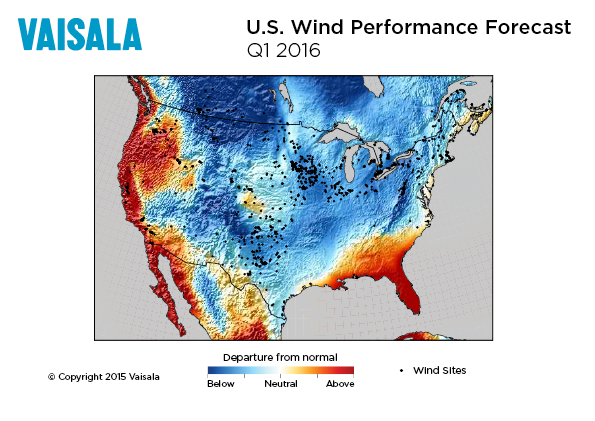 A strengthening El Niño weather pattern is expected to boost wind energy performance for West Coast investors and operators in the first quarter of 2016, while many regions of the United States will continue to feel the impact of below average wind speeds into next year. This is according to a forecast released by Vaisala, a global leader in environmental and industrial measurement.
A strengthening El Niño weather pattern is expected to boost wind energy performance for West Coast investors and operators in the first quarter of 2016, while many regions of the United States will continue to feel the impact of below average wind speeds into next year. This is according to a forecast released by Vaisala, a global leader in environmental and industrial measurement.
With record low wind speeds in 2015 continuing to raise concerns amongst U.S. wind investors and operators, particularly in California and Texas, Vaisala has been monitoring U.S. wind performance closely. In response to growing industry demand, Vaisala has now released a map illustrating expected wind conditions for Q1 2016, which was also covered in the Financial Times.
The study anticipates that key wind operating areas such as Texas, the Midwest, and the Northeast will see low wind conditions that are much less severe than the same period in Q1 2015, but nonetheless fall below long-term averages. Western states including California, Oregon, and Washington – home to 11.8GW of wind capacity – will, by contrast, see a marked increase in wind speeds.
Following the impact of an irregular first quarter in 2015, during which wind production in southern California fell to just 64% of 2014 levels, Vaisala’s latest forecast suggests that the CA-ISO (California independent system operator) energy market should see a major recovery in wind power deliveries. The same is true of BPA (Bonneville Power Administration), the Pacific Northwest power market, which encompasses Washington, Oregon, Idaho, and portions of other nearby states. This is due to the larger number of storms that typically sweep through the region during a strong El Niño, which could also help ease drought conditions in California.
Wind speeds are expected to remain lower than the historical average for the first quarter of the year in ERCOT (Texas) and the Southwest Power Pool (Nebraska, Kansas, and Oklahoma), areas where a high concentration of wind capacity has been installed. However, compared to the same period in 2015, wind speeds are expected to be 10-20% higher than last year during the same financial period.
Energy markets in the Midwest and Northeast (MISO, PJM, NY-ISO, and NE-ISO) are not expected to see a large improvement in wind conditions over last year. However, the warmer and milder winter conditions El Niño is expected to bring could also drive down energy demand and place less of a burden on the transmission system.
For investors, large-scale changes in wind speeds can lead to cash flow fluctuations that threaten profitability and the perception of wind energy as a low-risk investment proposition. For capital providers seeking stable returns through YieldCo structures in the U.S. market, the events of the past year as well as predictions for next year serve as a strong reminder to better diversity portfolios by geography and technology in order to account for the underlying variability of the climate.
“Now is the time to start building climate resilient portfolios,” said Pascal Storck, Global Manager of Energy Services at Vaisala. “This reduces the risk of low performance in any one region or technology. As the old adage goes, you don’t want to have all of your eggs in one basket. For example, you don’t want to have all of your assets in Texas and not have some mitigation strategy for when wind speeds dip below average for a period of time.”
Vaisala’s forecast is based on the wide agreement of the atmospheric research community and all the major global weather models that the current El Niño climate signal will continue and strengthen into next year. The forecast was created by examining several similar events from three of the leading reanalysis datasets, each representing 35 years, then generating a composite prediction based on the historical information.
For further details, please download Vaisala’s Q1 2016 forecast map.
Vaisala
www.vaisala.com/energy
Filed Under: News




